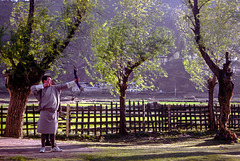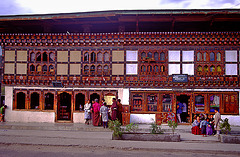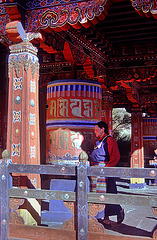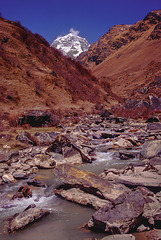Wolfgang's photos
Bhutanese man playing archery
| |
|
Archery tournaments are also very popular, but many of the participants and spectators are older Bhutanese. Archery has been practised in Bhutan for centuries, and is the only game, along with taekwondo, in which Bhutan has a chance of winning some medals at the next Olympic Games.
More description about archery I gave to my further posted pictures.
Street scenery in Paro
| |
|
Pass on the way to Ha
| |
|
|
Most travel agencies refuse to bring foreigners to Ha, but I can deeply recommend to do this tour (get a license before!!!).
Fantastic panorama views seen on the way from Paro to Ha. Unfortunately after some more kilometers we had to return due an old snow and ice avalanche blocked the road.
Spin the prayer wheel
| |
|
|
Prayer wheels are devices used by religious followers of the Buddha for spreading spiritual blessings and good will. Turning a prayer wheel symbolizes "turning the doctrine," referring to the first teachings of the Buddha, when he set the Wheel of the Law in motion, and accumulates virtues for the well being of mankind. Each turn is the equivalent of reading the prayers within.
Kyichu Lhakhang temple in the Paro Valley
| |
|
Kyichu Lhakhang or Kyerchu Temple is a Buddhist temple in Paro District on the way to Taksang and Drukgyel. It is one of the oldest monasteries in the country built in the 7th century.
Archery in Drukgyel
| |
|
Archery is the national sport of Bhutan, and every village has it own archery range. High spirited competitions, usually accompanied by a banquet, are a part of all festive occasions. Using bamboo bows (although modern compound bows are finding their way into the kingdom) teams of archers shoot at targets only 30 centimetres in diameter from a distance of 145 metres. Each team has a noisy crowd of supporters who, as well as encouraging their own side and try to out off the opposition.
Drukgyel, the starting point of our trek
| |
|
Passing the Chorten in the clockwise direction
| |
|
Pilgrims and travelers circumambulate stupas as a form of respect and devotion. Movement along the circular path (Tib. kora) is clockwise, so that the right shoulder is always facing the monument.
The Bhutanese style chorten is a square stone pillar with a khemar or red band near the top, and sometimes a representation of the sun and moon by a ball and crescent on the top. The square or rectangular base symbolizes the earth and the half-spherical dome symbolizes water. The crescent moon and a sun on top symbolize air, and a vertical spike symbolizes the sacred light of the Buddha. The life-spirit of the chorten is a carved wooden pole called sokshing, which is placed inside.
Chortens are sometimes built in memory of an individual, and other times to commemorate the visit of a saint, or to house sacred books or bodies of saints or great lamas.
A checkpoint on the way to the Chomolhari
| |
|
On this trekking route to the Chomolhari sanctuary we'd to pass two more checkpoints to show our trekking permit.
Mother with her child
| |
|
|
Across the Paro river
| |
|
Farmhouse at the Paro riverside
| |
|
|
Herds woman and her baby
| |
|
|
|
The young Paro river and the Chomolhari
| |
|
|
Chomolhari peak (7314 m?)
| |
|
|
There is no evidence that the mountain, whose official elevation is very close to a round 24,000 feet, has ever been accurately measured. Its true elevation may be nearer to 7,000 metres.
Despite its notability and spectacular visibility from the major trade route from India into Tibet's Phari Valley, the mountain has seen very little climbing activity, probably because of access restrictions on the Bhutanese side and the difficulty of the routes from the Tibetan site. The first ascent was made in May 1937 by a five-man British expedition, with F. Spencer Chapman and Sherpa Pasang Dawa Lama reaching the summit from Bhutan over the south-east spur. The second ascent was in 1970 over the same route by a joint Bhutanese-Indian military expedition led by Colonel Narendra Kumar. The third ascent was made in 1996 by a joint Japanese-Chinese expedition who reached the south col from the Tibetan side and climbed the peak over the south ridge. On May 7 2004, the British climbers Julie-Ann Clyma and Roger Payne reached the summit via the c. 5800 m south col as well, in a single day's dash from the col, after attempts to climb the impressive north-west pillar were thwarted by strong winds.
In October 2006, a six-member Slovenian team climbed two new routes, registering the fifth and sixth ascents. Rok Blagus, Tine Cuder, Samo Krmelj and Matej Kladnik took the left couloir of the north face to the East ridge at c. 7100 m, from which they followed the ridge to the top, while Marko Prezelj and Boris Lorencic climbed the north-west ridge in a six-day round trip. This climb earned Prezelj and Lorencic the Piolet d'Or in January 2007.
Chomolhari (7314 m?)
| |
|
Chomolhari, sometimes known as "the bride of Kangchenjunga”, is a mountain in the Himalayas, straddling the border between Yadong County of Tibet and the Paro district of Bhutan. The mountain is sacred to Tibetan Buddhists who make an annual pilgrimage from Phari Dzong to the holy lake Chomo Lharang at c. 5100 m just north of the mountain. The north face rises over 2700 metres (9,000 ft) above the barren plains.
Meeting a caravan
| |
|
There are regular caravans on the way to deliver the herders farm houses with necessary foods, clothes and other equipment
Jangothang the Chomolhary sanctuary
| |
|


















